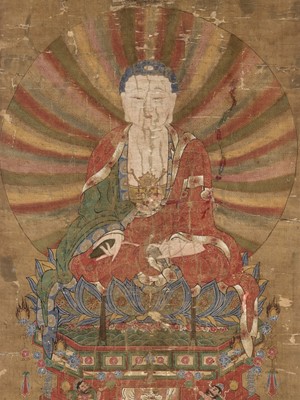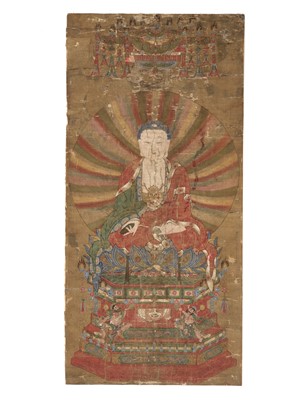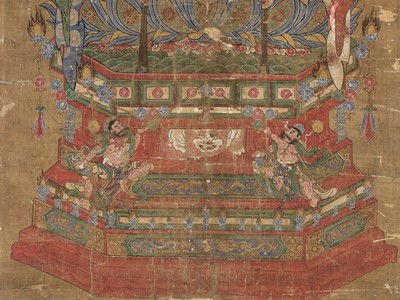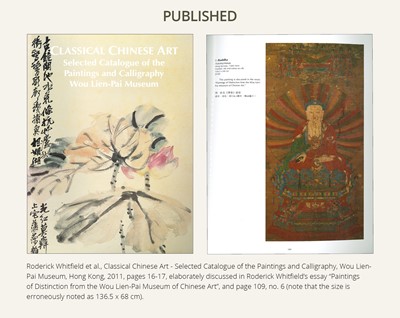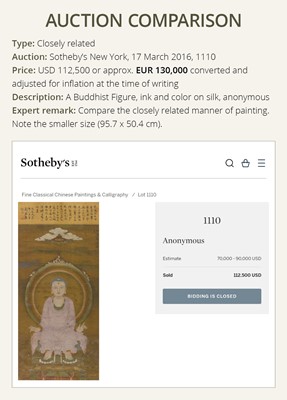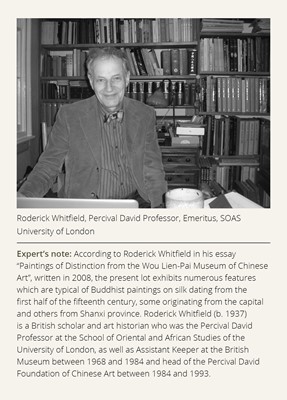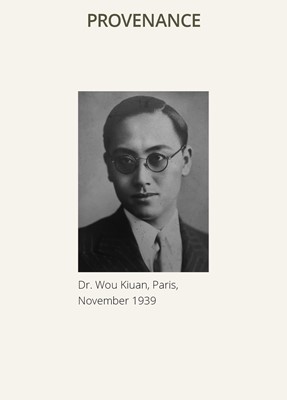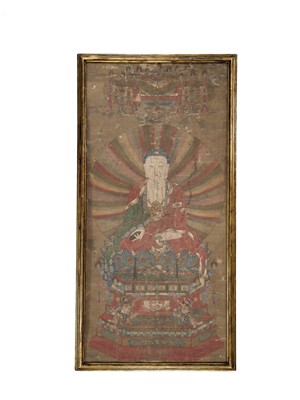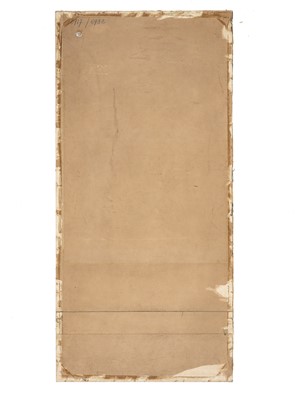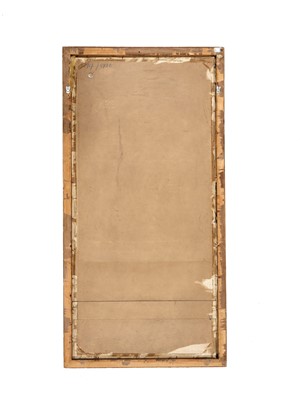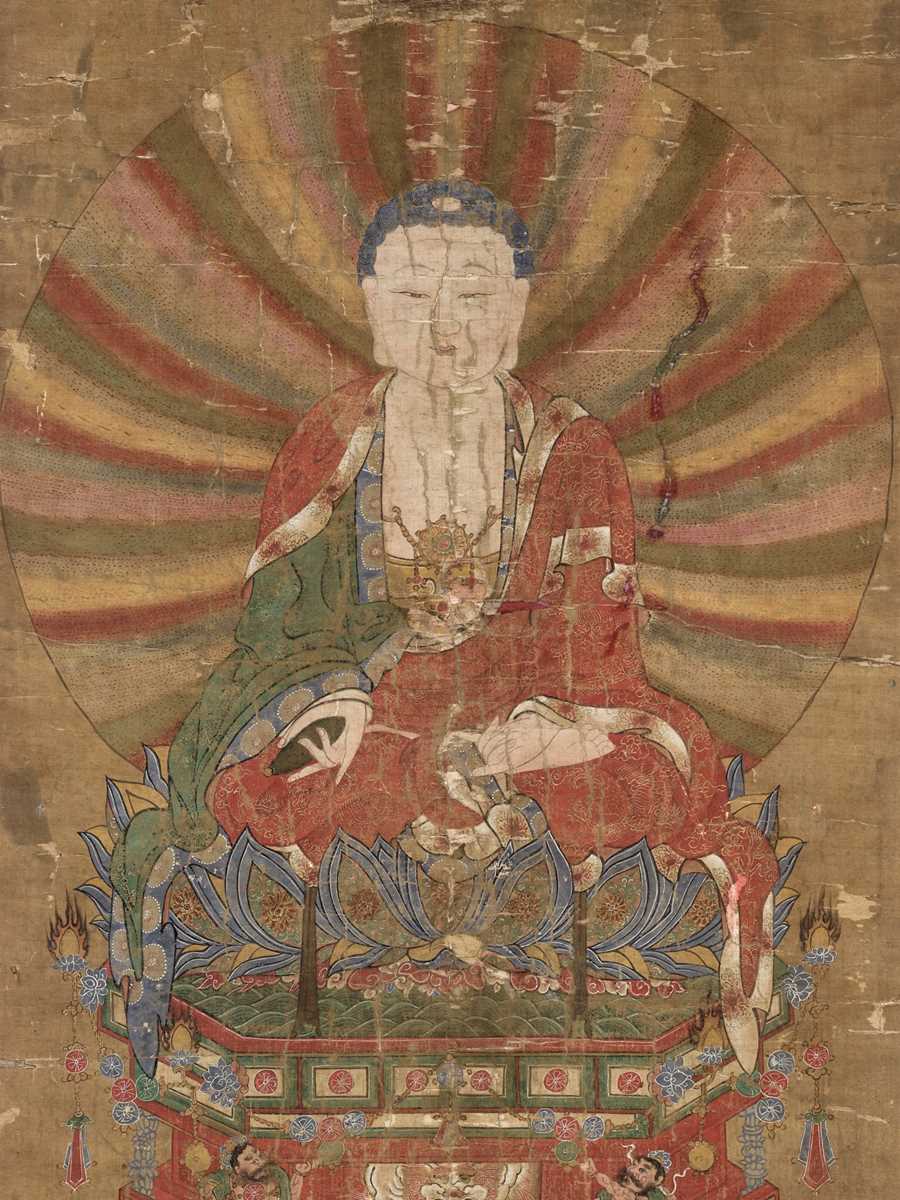9th Mar, 2023 13:00
TWO-DAY AUCTION - Fine Chinese Art / 中國藝術集珍 / Buddhism & Hinduism
197
AN IMPORTANT BUDDHIST VOTIVE PAINTING DEPICTING BUDDHA, EARLY MING DYNASTY, 1400-1450
1400-1500年明初重要還願佛陀坐蓮像
Sold for €20,800
including Buyer's Premium
Published: Roderick Whitfield et al., Classical Chinese Art - Selected Catalogue of the Paintings and Calligraphy, Wou Lien-Pai Museum, Hong Kong, 2011, pages 16-17, elaborately discussed in Roderick Whitfield’s essay “Paintings of Distinction from the Wou Lien-Pai Museum of Chinese Art”, and page 109, no. 6 (note that the size is erroneously noted as 136.5 x 68 cm).
Expert’s note: According to Roderick Whitfield in his essay “Paintings of Distinction from the Wou Lien-Pai Museum of Chinese Art”, written in 2008, the present lot exhibits numerous features which are typical of Buddhist paintings on silk dating from the first half of the fifteenth century, some originating from the capital and others from Shanxi province. Roderick Whitfield (b. 1937) is a British scholar and art historian who was the Percival David Professor at the School of Oriental and African Studies of the University of London, as well as Assistant Keeper at the British Museum between 1968 and 1984 and head of the Percival David Foundation of Chinese Art between 1984 and 1993.
China, first half of the 15th century. Ink and watercolors on silk. Depicting the Buddha seated on a double lotus over an elaborate hexagonal tiered throne supported by two striding guardian figures centered by a lion, his left hand holding a small flask and his right held above his lap, wearing loose-fitting robes and adorned with jewelry, backed by a circular halo of multi-colored rays of light. His serene face with heavy-lidded eyes and pursed lips, his blue hair arranged in spiral curls around the central ushnisha.
Provenance: From the collection of Dr. Wou Kiuan. Wou Lien-Pai Museum, coll. no. P.38. The frame with an old label, ‘KW P38’, as well as further old labels to the back. Dr. Wou Kiuan (1910-1997) was a Chinese diplomat and noted scholar of Chinese art. His father, Wou Lien-Pai (1873-1944), was one the leading political figures of early 20th century China, remembered for his role as speaker and leader of parliament during the turbulent years of the Republican era. Dr. Wou himself embarked on an illustrious career in diplomacy until his retirement in 1952, when he settled in London and devoted the rest of his life to the study of Chinese art. It was no doubt fortuitous that Dr. Wou’s years of collecting coincided with an abundant availability of exceptional Chinese art on the London market. From the mid-1950s to the late 1960s he was able to form a collection of well over 1,000 works that together represented virtually every category of Chinese art. At the heart of Dr. Wou’s drive to collect was a burning desire to preserve the relics of China’s rich historical past scattered across Europe, and to promote Chinese art and culture. It is unclear when Dr. Wou conceived of the idea to create a place to house his collection, but in 1968 he opened the doors to the Wou Lien-Pai Museum, named in honor of his father. Over the years the Museum became a ‘must see’ destination for collectors, academics, and visiting dignitaries, and Dr. Wou would delight in leading his visitors through the galleries, recounting stories of China’s glorious history.
Condition: Extensive wear, creasing, losses, tears, and soiling. Minor old touch-ups here and there. The wood frame with wear, chips, and losses.
Dimensions: Image size 148 x 70 cm, size incl. frame 157.5 x 80 cm
With a finely carved old gilt wood frame. (2)
The present image is a symbolic representation placed on a wall during Buddhist rituals. From the Buddhist perspective, paintings and calligraphy belong to Silpakarma-vidya, one of the five types of knowledge and wisdom. Over time monks and laymen painted and practiced calligraphy and Buddhist-themed works became more sophisticated during the Song and Yuan dynasties. By the early Ming dynasty, votive paintings, such as the present example, were used within private chapels and side pavilions of major temple monasteries.
As explained in Caroline Gyss-Vermandes’ pioneering article about the sets of Shuilu (Water and Land) paintings obtained by Paul Pelliot from “a library in the Imperial Palace” and now in the Musée Guimet (Démons et Merveilles: vision de la nature dans une peinture liturgique du XVe siècle, Arts Asiatiques 43, 1988, pages 106-122), such paintings were not objects of worship, but rather illustrations of the pantheon invoked in the Water and Land rituals, hung up in a prescribed order on the left and right walls of the sanctuary, while the main deities, in a larger size, were hung slightly higher on the north wall.
Literature comparison:
Compare a related painting of the Medicine Buddha, dated 1477, in the University of Oregon Museum of Art, illustrated in Marsha Weidner, Latter Days of the Law: Images of Chinese Buddhism 850-1850, cat. no. 5, pl. 3.
Auction result comparison:
Type: Closely related
Auction: Sotheby’s New York, 17 March 2016, 1110
Price: USD 112,500 or approx. EUR 130,000 converted and adjusted for inflation at the time of writing
Description: A Buddhist Figure, ink and color on silk, anonymous
Expert remark: Compare the closely related manner of painting. Note the smaller size (95.7 x 50.4 cm).
1400-1500年明初重要還願佛陀坐蓮像
中國,十五世紀上半葉,絹本水墨設色。佛陀結跏趺坐坐在雙層蓮座上,他左手拿著一個小瓶,右手放在膝蓋上,穿著寬鬆的袈裟,裝飾著瓔珞,後有多色圓形光背。面容祥和,雙眼微垂,頭髮成螺髮肉髻。蓮座置於精美的六角形寶座上,下有兩個騎獅守護神。
出版:Roderick Whitfield et al.,《Classical Chinese Art - Selected Catalogue of the Paintings and Calligraphy》,吳蓮伯美術館,香港,2011年,頁16-17,Roderick Whitfield的文章 “Paintings of Distinction from the Wou Lien-Pai Museum of Chinese Art”,頁109,圖 6 (請注意,錯誤尺寸136.5 x 68 厘米)。
專家注釋:根據Roderick Whitfield 在他的文章 “Paintings of Distinction from the Wou Lien-Pai Museum of Chinese Art”,2008年,本拍品具有十五世紀上半葉絹本佛教畫作的眾多特徵,有的出自北京,有的出自山西省。Roderick Whitfield(生於 1937 年)是英國學者和藝術史學家,曾任倫敦大學亞非學院 Percival David 教授,並於 1968 年至 1984 年間擔任大英博物館助理館長和博物館館長 以及1984 年至 1993 年間擔任Percival David 中國藝術基金會會長。
來源:吳權博士收藏;吳蓮伯美術館,館藏編號 P.38。框上和背面有老標籤。吳權(1910-1997)博士 曾是一位中國外交家以及知名中國藝術收藏家。他的父親吳蓮伯 (1873-1944)先生曾是二十世紀初中國重要政治人物,因在民國動蕩歲月中擔任國會議員及議長而聞名。1952 年,吳博士在外交領域走上了輝煌之路,直到他退休後定居倫敦,並將餘生奉獻給了對中國藝術的研究。毫無疑問,吳權博士多年的收藏,與大量中國藝術珍品現身倫敦藝術市場上時間點相呼應,這無疑是幸運的。從 1950 年代中期到 1960 年代後期,他收集了 1,000 多件藏品,涵蓋了中國藝術的每一個門類。吳博士之所以收藏,其原因主要是爲保護散落歐洲各地的中國文物與推廣中國藝術與文化。尚不清楚吳博士何時想到創建一個美術館來歸置他的收藏的,但在 1968 年,他打開了以他父親的名字命名的 吳蓮伯美術館的大門。多年來,美術館已成為收藏家、學者和來訪政要的必經之地,而吳博士總是很樂意給參觀者介紹美術館,講述中國光輝歷史的故事。
品相:大量磨損、摺痕、缺損、撕裂和汙跡,多處輕微的小修補,木框有磨損、刻痕和缺損。
尺寸:畫面148 x 70 厘米,含框 157.5 x 80 厘米
描金雕刻木框 (2)
正如 Caroline Gyss-Vermandes 關於 Paul Pelliot 從故宮圖書館獲得的水陸畫的開創性文章中所解釋的那樣,現在在 Musée Guimet(Démons et Merveilles:vision de la nature dans une peinture liturgique du XVe siècle,Arts Asiatiques 43,1988,pages 106-122),這些畫不是崇拜的對象,而是在水陸儀式中調用的,按照規定的順序,主神像較大,一般掛在北壁稍高處。
文獻比較:
比較一件相近的1477年藥師佛畫像 ,收藏於University of Oregon Museum of Art,見Marsha Weidner,《Latter Days of the Law: Images of Chinese Buddhism 850-1850》,圖錄編號5,圖3。
拍賣結果比較:
形制:非常相近
拍賣:紐約蘇富比,2016年3月17日,1110
價格:USD 112,500(相當於今日EUR 130,000)
描述:上方廣眾德佛,設色絹本鏡框
專家評論:比較非常相近繪畫風格。請注意尺寸較小(95.7 x 50.4 厘米)。
Published: Roderick Whitfield et al., Classical Chinese Art - Selected Catalogue of the Paintings and Calligraphy, Wou Lien-Pai Museum, Hong Kong, 2011, pages 16-17, elaborately discussed in Roderick Whitfield’s essay “Paintings of Distinction from the Wou Lien-Pai Museum of Chinese Art”, and page 109, no. 6 (note that the size is erroneously noted as 136.5 x 68 cm).
Expert’s note: According to Roderick Whitfield in his essay “Paintings of Distinction from the Wou Lien-Pai Museum of Chinese Art”, written in 2008, the present lot exhibits numerous features which are typical of Buddhist paintings on silk dating from the first half of the fifteenth century, some originating from the capital and others from Shanxi province. Roderick Whitfield (b. 1937) is a British scholar and art historian who was the Percival David Professor at the School of Oriental and African Studies of the University of London, as well as Assistant Keeper at the British Museum between 1968 and 1984 and head of the Percival David Foundation of Chinese Art between 1984 and 1993.
China, first half of the 15th century. Ink and watercolors on silk. Depicting the Buddha seated on a double lotus over an elaborate hexagonal tiered throne supported by two striding guardian figures centered by a lion, his left hand holding a small flask and his right held above his lap, wearing loose-fitting robes and adorned with jewelry, backed by a circular halo of multi-colored rays of light. His serene face with heavy-lidded eyes and pursed lips, his blue hair arranged in spiral curls around the central ushnisha.
Provenance: From the collection of Dr. Wou Kiuan. Wou Lien-Pai Museum, coll. no. P.38. The frame with an old label, ‘KW P38’, as well as further old labels to the back. Dr. Wou Kiuan (1910-1997) was a Chinese diplomat and noted scholar of Chinese art. His father, Wou Lien-Pai (1873-1944), was one the leading political figures of early 20th century China, remembered for his role as speaker and leader of parliament during the turbulent years of the Republican era. Dr. Wou himself embarked on an illustrious career in diplomacy until his retirement in 1952, when he settled in London and devoted the rest of his life to the study of Chinese art. It was no doubt fortuitous that Dr. Wou’s years of collecting coincided with an abundant availability of exceptional Chinese art on the London market. From the mid-1950s to the late 1960s he was able to form a collection of well over 1,000 works that together represented virtually every category of Chinese art. At the heart of Dr. Wou’s drive to collect was a burning desire to preserve the relics of China’s rich historical past scattered across Europe, and to promote Chinese art and culture. It is unclear when Dr. Wou conceived of the idea to create a place to house his collection, but in 1968 he opened the doors to the Wou Lien-Pai Museum, named in honor of his father. Over the years the Museum became a ‘must see’ destination for collectors, academics, and visiting dignitaries, and Dr. Wou would delight in leading his visitors through the galleries, recounting stories of China’s glorious history.
Condition: Extensive wear, creasing, losses, tears, and soiling. Minor old touch-ups here and there. The wood frame with wear, chips, and losses.
Dimensions: Image size 148 x 70 cm, size incl. frame 157.5 x 80 cm
With a finely carved old gilt wood frame. (2)
The present image is a symbolic representation placed on a wall during Buddhist rituals. From the Buddhist perspective, paintings and calligraphy belong to Silpakarma-vidya, one of the five types of knowledge and wisdom. Over time monks and laymen painted and practiced calligraphy and Buddhist-themed works became more sophisticated during the Song and Yuan dynasties. By the early Ming dynasty, votive paintings, such as the present example, were used within private chapels and side pavilions of major temple monasteries.
As explained in Caroline Gyss-Vermandes’ pioneering article about the sets of Shuilu (Water and Land) paintings obtained by Paul Pelliot from “a library in the Imperial Palace” and now in the Musée Guimet (Démons et Merveilles: vision de la nature dans une peinture liturgique du XVe siècle, Arts Asiatiques 43, 1988, pages 106-122), such paintings were not objects of worship, but rather illustrations of the pantheon invoked in the Water and Land rituals, hung up in a prescribed order on the left and right walls of the sanctuary, while the main deities, in a larger size, were hung slightly higher on the north wall.
Literature comparison:
Compare a related painting of the Medicine Buddha, dated 1477, in the University of Oregon Museum of Art, illustrated in Marsha Weidner, Latter Days of the Law: Images of Chinese Buddhism 850-1850, cat. no. 5, pl. 3.
Auction result comparison:
Type: Closely related
Auction: Sotheby’s New York, 17 March 2016, 1110
Price: USD 112,500 or approx. EUR 130,000 converted and adjusted for inflation at the time of writing
Description: A Buddhist Figure, ink and color on silk, anonymous
Expert remark: Compare the closely related manner of painting. Note the smaller size (95.7 x 50.4 cm).
1400-1500年明初重要還願佛陀坐蓮像
中國,十五世紀上半葉,絹本水墨設色。佛陀結跏趺坐坐在雙層蓮座上,他左手拿著一個小瓶,右手放在膝蓋上,穿著寬鬆的袈裟,裝飾著瓔珞,後有多色圓形光背。面容祥和,雙眼微垂,頭髮成螺髮肉髻。蓮座置於精美的六角形寶座上,下有兩個騎獅守護神。
出版:Roderick Whitfield et al.,《Classical Chinese Art - Selected Catalogue of the Paintings and Calligraphy》,吳蓮伯美術館,香港,2011年,頁16-17,Roderick Whitfield的文章 “Paintings of Distinction from the Wou Lien-Pai Museum of Chinese Art”,頁109,圖 6 (請注意,錯誤尺寸136.5 x 68 厘米)。
專家注釋:根據Roderick Whitfield 在他的文章 “Paintings of Distinction from the Wou Lien-Pai Museum of Chinese Art”,2008年,本拍品具有十五世紀上半葉絹本佛教畫作的眾多特徵,有的出自北京,有的出自山西省。Roderick Whitfield(生於 1937 年)是英國學者和藝術史學家,曾任倫敦大學亞非學院 Percival David 教授,並於 1968 年至 1984 年間擔任大英博物館助理館長和博物館館長 以及1984 年至 1993 年間擔任Percival David 中國藝術基金會會長。
來源:吳權博士收藏;吳蓮伯美術館,館藏編號 P.38。框上和背面有老標籤。吳權(1910-1997)博士 曾是一位中國外交家以及知名中國藝術收藏家。他的父親吳蓮伯 (1873-1944)先生曾是二十世紀初中國重要政治人物,因在民國動蕩歲月中擔任國會議員及議長而聞名。1952 年,吳博士在外交領域走上了輝煌之路,直到他退休後定居倫敦,並將餘生奉獻給了對中國藝術的研究。毫無疑問,吳權博士多年的收藏,與大量中國藝術珍品現身倫敦藝術市場上時間點相呼應,這無疑是幸運的。從 1950 年代中期到 1960 年代後期,他收集了 1,000 多件藏品,涵蓋了中國藝術的每一個門類。吳博士之所以收藏,其原因主要是爲保護散落歐洲各地的中國文物與推廣中國藝術與文化。尚不清楚吳博士何時想到創建一個美術館來歸置他的收藏的,但在 1968 年,他打開了以他父親的名字命名的 吳蓮伯美術館的大門。多年來,美術館已成為收藏家、學者和來訪政要的必經之地,而吳博士總是很樂意給參觀者介紹美術館,講述中國光輝歷史的故事。
品相:大量磨損、摺痕、缺損、撕裂和汙跡,多處輕微的小修補,木框有磨損、刻痕和缺損。
尺寸:畫面148 x 70 厘米,含框 157.5 x 80 厘米
描金雕刻木框 (2)
正如 Caroline Gyss-Vermandes 關於 Paul Pelliot 從故宮圖書館獲得的水陸畫的開創性文章中所解釋的那樣,現在在 Musée Guimet(Démons et Merveilles:vision de la nature dans une peinture liturgique du XVe siècle,Arts Asiatiques 43,1988,pages 106-122),這些畫不是崇拜的對象,而是在水陸儀式中調用的,按照規定的順序,主神像較大,一般掛在北壁稍高處。
文獻比較:
比較一件相近的1477年藥師佛畫像 ,收藏於University of Oregon Museum of Art,見Marsha Weidner,《Latter Days of the Law: Images of Chinese Buddhism 850-1850》,圖錄編號5,圖3。
拍賣結果比較:
形制:非常相近
拍賣:紐約蘇富比,2016年3月17日,1110
價格:USD 112,500(相當於今日EUR 130,000)
描述:上方廣眾德佛,設色絹本鏡框
專家評論:比較非常相近繪畫風格。請注意尺寸較小(95.7 x 50.4 厘米)。
Zacke Live Online Bidding
Our online bidding platform makes it easier than ever to bid in our auctions! When you bid through our website, you can take advantage of our premium buyer's terms without incurring any additional online bidding surcharges.
To bid live online, you'll need to create an online account. Once your account is created and your identity is verified, you can register to bid in an auction up to 12 hours before the auction begins.
Intended Spend and Bid Limits
When you register to bid in an online auction, you will need to share your intended maximum spending budget for the auction. We will then review your intended spend and set a bid limit for you. Once you have pre-registered for a live online auction, you can see your intended spend and bid limit by going to 'Account Settings' and clicking on 'Live Bidding Registrations'.
Your bid limit will be the maximum amount you can bid during the auction. Your bid limit is for the hammer price and is not affected by the buyer’s premium and VAT. For example, if you have a bid limit of €1,000 and place two winning bids for €300 and €200, then you will only be able to bid €500 for the rest of the auction. If you try to place a bid that is higher than €500, you will not be able to do so.
Online Absentee and Telephone Bids
You can now leave absentee and telephone bids on our website!
Absentee Bidding
Once you've created an account and your identity is verified, you can leave your absentee bid directly on the lot page. We will contact you when your bids have been confirmed.
Telephone Bidding
Once you've created an account and your identity is verified, you can leave telephone bids online. We will contact you when your bids have been confirmed.
Classic Absentee and Telephone Bidding Form
You can still submit absentee and telephone bids by email or fax if you prefer. Simply fill out the Absentee Bidding/Telephone bidding form and return it to us by email at office@zacke.at or by fax at +43 (1) 532 04 52 20. You can download the PDF from our Upcoming Auctions page.
How-To Guides
How to Create Your Personal Zacke Account
How to Register to Bid on Zacke Live
How to Leave Absentee Bids Online
How to Leave Telephone Bids Online
中文版本的操作指南
创建新账号
注册Zacke Live在线直播竞拍(免平台费)
缺席投标和电话投标
Third-Party Bidding
We partner with best-in-class third-party partners to make it easy for you to bid online in the channel of your choice. Please note that if you bid with one of our third-party online partners, then there will be a live bidding surcharge on top of your final purchase price. You can find all of our fees here. Here's a full list of our third-party partners:
- 51 Bid Live
- EpaiLive
- ArtFoxLive
- Invaluable
- LiveAuctioneers
- the-saleroom
- lot-tissimo
- Drouot
Please note that we place different auctions on different platforms. For example, in general, we only place Chinese art auctions on 51 Bid Live.
Bidding in Person
You must register to bid in person and will be assigned a paddle at the auction. Please contact us at office@zacke.at or +43 (1) 532 04 52 for the latest local health and safety guidelines.
